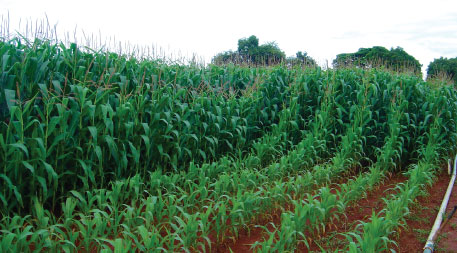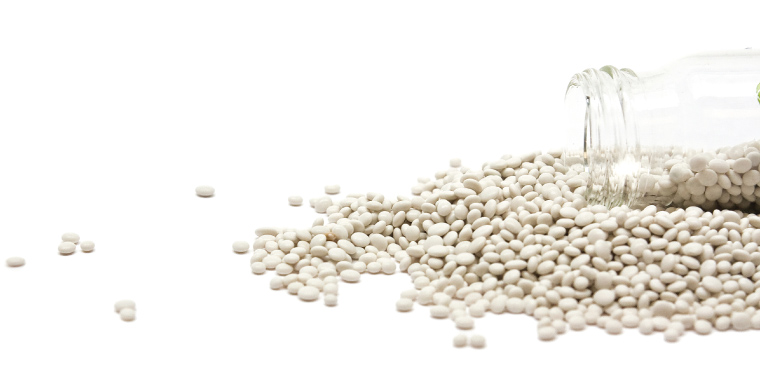June 4, 2013 — In Aldous Huxley’s dystopian Brave New World, citizens contribute to society even after death. As gases exit a crematorium smokestack, a special device recovers phosphorus — “more than a kilo and a half per adult corpse.” The recovered phosphorus then fertilizes all manner of plant life, which thrives on this vital nutrient recycled from the remains of the dead.
Huxley’s account is remarkable because it was written in the early 1930s, when far less public attention was devoted to the supply of natural resources. In fact, the full potential of phosphorus would be demonstrated several decades later. Its targeted use fueled the green revolution of the 1960s and 1970s, which dramatically improved crop yields and helped minimize the proportion of the world’s population remaining underfed.

Adding phosphorus to nutrient-poor soils can dramatically enhance crop production. Maize plants in the foreground of this photo taken on Brazil’s cerrado are growing on unsupplemented soil; the taller ones behind them received phosphorus fertilizer. Photo by D.M.G. De Sousa.
Farmers around the world have come to depend on manufactured inorganic fertilizers containing key plant nutrients phosphorus, nitrogen and potassium to enhance soil fertility, especially in the otherwise poor soils of most tropical settings. But while all three are relatively abundant in nature, commercially viable sources of phosphorus to make these fertilizers could be exhausted just a few decades from now. That prospect, which remains a source of heated debate, has spurred a drive to recover the significant quantities of this element that disappear in the waste streams of cities and farms. Such recovery would have a bonus benefit: Even without the threat of shortages, minimizing the disposal of phosphorus is increasingly key to preventing degradation of valuable freshwater resources.
Momentous Shift
The availability of nitrogen, phosphorus and potassium in soil is a limiting factor in plant growth. The limitation imposed by phosphorus is the strictest, based on the amount of this material that plants take up and concentrate. Since all living organisms incorporate phosphorus in varying chemical combinations, modest amounts are relatively easy to obtain from biological sources. Spreading animal manure on fields is among the oldest known ways to add phosphorus to a crop. Urine can also be effective. Guano from birds and bats is exceptionally rich in this regard, as is bone meal.
“Increasing environmental, economic, geopolitical and social concerns about the short- and long-term use of phosphate rock in agriculture means there is a need to reassess the way crops obtain their phosphorus and humanity is fed.” — Dana CordellYet even as Huxley was writing, and certainly by the time the green revolution rolled around, such organic inputs were no longer sufficient to match the scale of agricultural output. As a result, most of the phosphorus that ends up on fields today comes not from organic materials, but from inorganic phosphates extracted from geological deposits.
This distinction makes no difference to crops. For our society and economy, on the other hand, the shift has been nothing less than momentous.
“Today, we are effectively dependent on phosphorus from mined phosphate rock,” says environmental scientist Dana Cordell, a research principal at the Institute for Sustainable Futures in Sydney, Australia. In many places, such as Brazil or central Africa, phosphate-based fertilizers are essential to maintaining crop yields and ensuring domestic food security. And that, Cordell says, spells trouble. For her, inorganic phosphates represent a nonrenewable resource that contrasts sharply with traditional sources of phosphorus such as manure, which are integrated into a natural environmental cycle. And because they’re only found in certain areas, global politics comes into play.
“Increasing environmental, economic, geopolitical and social concerns about the short- and long-term use of phosphate rock in agriculture means there is a need to reassess the way crops obtain their phosphorus and humanity is fed,” she says.
Peak Phosphorus?
Some, including Cordell, see a limited future for the conventional mining of phosphates. Easily obtained, high-quality deposits of this material will become harder to find, and its price could be expected to rise accordingly. Production should ultimately peak as commercially viable supplies become more limited, reducing the amount of phosphorus available for use as fertilizer. This reduction would be reflected by declining agricultural production in some parts of the world, along with the specter of mounting hunger.
What remains a point of contention is exactly when such problems might arise. Cordell and others insist that this scenario could play out in a very few decades, as the quality of available phosphate begins to decline.
“Importantly, this means increasing energy and other resources (like sulfur) are therefore required to mine, process and extract the same nutrient value from phosphate rock while simultaneously generating more waste,” she says. “Further, the global trade of phosphate commodities to the farm gate currently relies on fossil fuel energy, yet in a carbon-constrained future, shipping millions of tons of phosphate rock and fertilizers around the globe may no longer be appropriate or possible.”
Ensia shares solutions-focused stories free of charge through our online magazine and partner media. That means audiences around the world have ready access to stories that can — and do — help them shape a better future. If you value our work, please show your support today.
Yes, I'll support Ensia!

Small scale and organic is already feeding the large majority of the world, probably in the neighborhood of 70% or so. Yet we spend so much time worrying about industrial totalitarian agriculture. Why should this be? Because it is the industrialized countries that mostly eat the food that comes from this system. It's not really the developing world that needs totalitarian agriculture, it's us, the privileged. It's us who would starve because we have become so divorced from where our food comes from and how to go about growing it.
Plus, organic farms per se are not always closed loop nutrient systems. They often depend on manure inputs, usually from conventional farms (often with chemical fertilizers used in the animal feed) down the road. It's rare to find any truly closed nutrient loops in agriculture anywhere, conventional or organic. So, organic is not automatically a solution to all of this, although it is clearly better in many respects.
With that said, major changes in nutrient use is needed, and you identify a great many of the challenges we need to address. It's a big problem.
I agree that Certified Organic agriculture is almost identical to industrial chemical agriculture. It is still a tilled monocultural disaster. It just doesn't have the poisons as an input, and so is marginally better for us and ecosystems. But still disastrous.
As for the 70% figure... I am talking about global food provisioning. Not your food, not my food. Global. We live in the "First World." (I assume you live in a "First World" nation...)
Here is a summary of a report that estimates, because the hard data is not available, that conservatively "70% of the food the world actually consumes every year is provisioned by rural and urban
peasants." Peasants can't afford chemicals or seed, and so have to find other ways to ensure fertility. They may not be Certified Organic, but they are cycling nutrients somehow. http://www.etcgroup.org/sites/www.etcgroup.org/files/Who%20will%20feed%20us%20all.pdf
Here is another little tidbit out of Russia that says that small family held farms are producing a sizable quantity of food in that industrialized country. http://thebovine.wordpress.com/2009/08/09/in-1999-35-million-small-family-plots-produced-90-of-russias-potatoes-77-of-vegetables-87-of-fruits-59-of-meat-49-of-milk-way-to-go-people/
Other estimates say that about 15% of food production is in urban areas, 85% of food is "local," and 75% of farmers save seed and grow locally adapted varieties. If you are saving seed, you're probably not dousing it with chemicals.
Like I said before, if the industrial agriculture system were to fail tomorrow, it would be you and I that would probably starve. We are heavily invested in the linear paradigm of food production. Our lives depend on it. The non-industrialized parts of the world would get along pretty well. I humbly propose that we have a lot to learn and the poorest among us should be our teachers. But if we live under the illusion that industrial agriculture is currently feeding most of the people, then we won't be able to visualize what is possible from a different paradigm.
Shouldn't Ensia, a blog about sustainability, have articles that are framed within a sustainability paradigm?
So, help is on the way! (?)